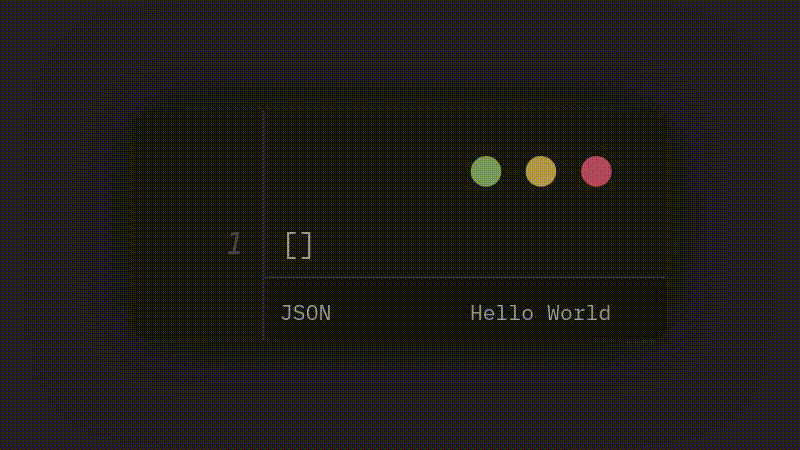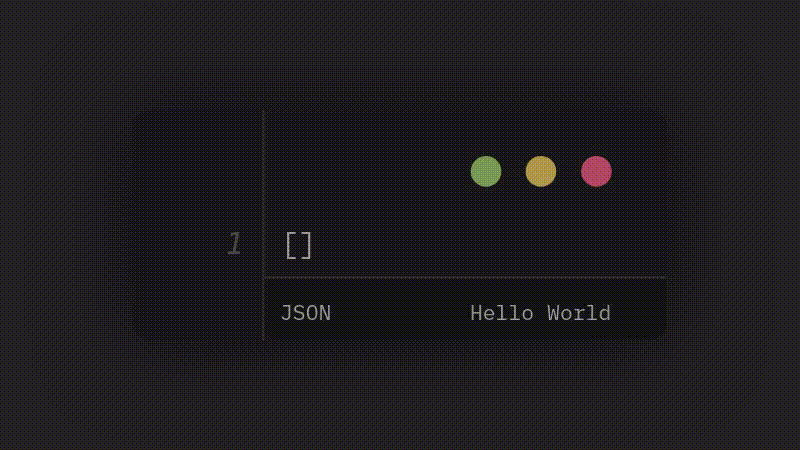Package Exports
- @codemovie/code-movie-marked-plugin
- @codemovie/code-movie-marked-plugin/dist/index.js
This package does not declare an exports field, so the exports above have been automatically detected and optimized by JSPM instead. If any package subpath is missing, it is recommended to post an issue to the original package (@codemovie/code-movie-marked-plugin) to support the "exports" field. If that is not possible, create a JSPM override to customize the exports field for this package.
Readme
Code.Movie plugin for Marked
Author animated code examples with markdown! This plugin extends markdown with a wrapper syntax for fenced code blocks:
%%%(json)
%%
[]
%%
%%
["World"]
%%
%%
["Hello", "World"]
%%
%%
[
"Hello",
"World"
]
%%
%%%Combined with a moderate amount of plugin configuration the above turns into animated, syntax highlighted code:

Installation
You can install the library as @codemovie/code-movie-marked-plugin from NPM,
download the latest release from GitHub
or just grab index.js from the source code.
Demo
After installation, run npm demo and visit localhost:3000/demo/index.html
for a simple demo page. The source code is unminified and has extensive
comments.
Setup
This plugin does not bundle the core library! You have to either manually install @codemovie/code-movie or load the relevant files from a CDN like jsDelivr as shown below:
// Import Marked and the plugin
import { marked } from "https://cdn.jsdelivr.net/npm/marked@15.0.6/lib/marked.esm.js";
import { markedCodeMoviePlugin } from "./plugin/code-movie-marked-plugin/index.js";
// For flexibility reasons, the plugin does not ship with the main library.
// You need to load the required functions, themes and language modules from
// somewhere, either a CDN as shown below or from your local installation of
// @codemovie/code-movie.
import {
animateHTML,
monokaiDark,
} from "https://cdn.jsdelivr.net/npm/@codemovie/code-movie/dist/index.js";
import json from "https://cdn.jsdelivr.net/npm/@codemovie/code-movie/dist/languages/json.js";
import ecmascript from "https://cdn.jsdelivr.net/npm/@codemovie/code-movie/dist/languages/ecmascript.js";
// The plugin can automatically add markup for <code-movie-runtime> custom
// elements, but this too requires the module for the element to be loaded
import "https://cdn.jsdelivr.net/npm/@codemovie/code-movie-runtime";
// Set the options for the plugin
const codeMoviePlugin = markedCodeMoviePlugin({
// Because the core library is not bundled with the plugin, you need to
// provide an adapter function. The adapter function is called with the array
// of frame objects, the relevant language object, and the Marked token for
// the animation. You can pass the first two arguments on to your particular
// version of the core library. The token might be interesting if you want to
// run `animateHTML()` with different arguments depending on metadata present
// in the token. If you want to tweak the tab size, theme, or run some side
// effects (maybe depending on the aforementioned metadata), this is the place
// to do that. You can also add extra HTML before, after, or around the
// output... or not call `animateHTML()` at all, but rather do something else
// with the raw data.
adapter(frames, language, token) {
return animateHTML(frames, {
tabSize: 2,
language,
theme: monokaiDark,
});
},
// Because the language modules are HUGE and can be configured in a variety
// of ways, you may want to be selective about what you include and how you
// configure each language.
languages: {
// Every entry in the languages object maps a class name ("json" in this
// case) to a language module instance. To then create an animation for
// JSON, you'll need an element with the class "code-movie" (as defined in
// the selector option above) and also the class "json". <pre> elements
// inside this element (again, as defined by the selector option) will
// then be processed and animated als JSON.
json: json(),
// Here, the class "javascript" maps to the ecmascript module with types
// disabled, while the class "typescript" maps to the same language
// module, but with types enabled.
javascript: ecmascript({ ts: false }),
typescript: ecmascript({ ts: true }),
},
// To automatically add markup for <code-movie-runtime> custom elements, set
// the "addRuntime" option to something truthy. To initialize the
// <code-movie-runtime> tags with the "controls" attribute, pass an object
// with the controls property set to something truthy. If you need more
// customization, consider extending the adapter function.
addRuntime: {
controls: true,
},
});
// Pass the plugin to Marked. Done!
marked.use(codeMoviePlugin);
// Time to parse some markdown...
const markdown = await fetch("./content.md").then((res) => res.text());
document.body.innerHTML += marked.parse(markdown);Syntax
The animation comprises of a wrapper block that starts and ends with %%%,
and code blocks that start and end with %%. The wrapper block requires a
header, wrapped in parenthesis, which must at least specify the language to
use:
%%%(json)
%%
"Code Block content"
%%
%%%Apart from the language, headers can also specify other arguments. These are
pairs of key and JSON5-encoded values
that pass additional information. Keys always start with a pipe (|) symbol.
Currently there are to arguments available:
|metafor both wrapper and code blocks|decorationsfor code blocks only
Example:
%%%(json|meta={ value: "This is metadata!" })
%%(|meta={ value: "This is also metadata!" })
"Code Block content"
%%
%%%Data from |meta can be used as token.meta in the adapter function, while
|decorations is specifically for passing Decorations
to Code.Movie. Both types of arguments are explained in more detail below.
Metadata: |meta
You can add any metadata you like as a JSON5-encoded object to a wrapper block or code block. In case of wrapper blocks the metadata argument (like all arguments) must come after the language. The argument is always optional and defaults to an empty object:
%%%(json|meta={ value: "Metadata for the entire animation" })
%%(json|meta={ value: "Metadata for the first frame" })
[23]
%%
%%(json|meta={ value: "Metadata for the second frame" })
[42]
%%
%%%The object can contain line breaks.
|meta on wrapper blocks
Metadata on wrapper blocks has no immediate effect, but is is available as
token.meta in the adapter function. You could use to control markup creation
(to eg. allow ad-hoc addition of custom properties)
or switch themes entirely.
|meta on code blocks
Metadata on code blocks has no immediate effect, but gets added to the meta
property on the frame objects available in the adapter function.
Decorations: |decorations
You can add decorations as JSON5-encoded arrays
to the individual code blocks inside a code-movie block. Thedata fields are
optional and default to empty objects.
%%%(json)
%%
[]
%%
%%|decorations=[{ kind: "TEXT", from: 1, to: 8 }]
["World"]
%%
%%|decorations=[{ kind: "TEXT", from: 1, to: 8 }, { kind: "TEXT", from: 10, to: 17, data: { class: "error" } }]
["Hello", "World"]
%%
%%|decorations=[{ kind: "GUTTER", text: "✅", line: 2 }, { kind: "GUTTER", text: "🚫", line: 3 }]
[
"Hello",
"World"
]
%%
%%%Neither the decoration objects nor the containing array can currently contain line breaks.

Customization
You can read up on styling and theming in the Code.Movie documentation!